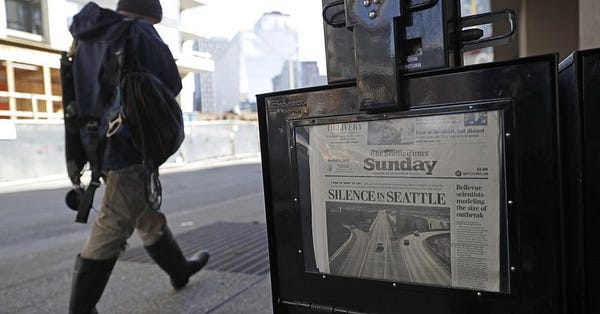When the government handed out its $669 billion Paycheck Protection Program (of which, $521 billion has been doled out), it was designed to help small businesses (companies with fewer than 500 employees) make sure they didn’t lay anyone off due to the financial impact of the coronavirus.
Media companies have been hit hard over the last four months. As advertisers pulled spend because they, too, have to navigate this pandemic, and publisher revenue streams from events nosedived, media companies were faced with tough personnel decisions.
The result: close to 40,000 media workers (from journalists to sales to ad ops to events teams) were laid off or furloughed. Poynter has an ongoing tally of all the media folk laid off during this time.
On Monday, the Small Business Administration (SBA), which oversees the PPP loan program, released all the companies’ names who received more than $150,000 in loans. As a reminder, the loans charge 1 percent interest and can be forgiven if the companies use the money to continue paying staff.
But looking at the media companies that received PPP loans, some appear to have staved off layoffs, while others took money and still let employees go. Running a business, media or other, is challenging under ideal circumstances, let alone a global pandemic.
I hope the media companies that laid off workers and then received PPP loans do the right thing and hire their folks back. Though knowing how this industry operates, I’m not particularly sanguine that it will happen. I imagine many media companies will hire again, but at reduced salaries arbitraging, in a way, the PPP loan.
Some companies, like Axios, received PPP money but wound up returning its $4.8 million loan after saying it found another revenue stream.
This is a good thread from CNN’s Kerry Flynn, who’s been keeping track of companies that applied/received/returned PPP money since April.


Of course, media companies weren’t the only ones in the industry to receive tax-payer money. The Washington Post outlines how tech firms, venture capital firms and private equity firms received, and how some of these companies are claiming not only did they not receive money, but they never applied.
According to a CNBC report, an unnamed senior administration official said companies have already paid back or canceled $30 billion of the loans.
You can spend your day trawling through the SBA list of all companies that received more than $150,000 in PPP loans. You can also check out this cool interactive map that lets you find companies that received PPP just by entering in a zip code.
Here’s a sprinkle of some media orgs that received some money. You’ll note the ranges of requests, and how some, like The Skimm, received a hefty loan (The Skimm received between $2 million and $5 million) while also laying off about 20 percent of its 130-person staff in May.
If you happen to look at the spreadsheet and see other media companies, drop ‘em in the comments.
AM N.Y.: $2 million to $5 million
Apartment Therapy: $1 million to $2 million
Atlas Obscura: $1 million to $2 million
Bustle Digital Group: $5 million to $10 million
Crain Communications: $5 million to $10 million
Digiday Media: $1 million to $2 million
Entrepreneur Media: $1 million to $2 million
Essence Media: $2.4 million
Forbes Media: $5 million to $10 million
Fortune Media: $3.2 million
Future Media: $1 million to $2 million
Harper’s Magazine Foundation: $350,000 to $1 million
Her Campus: $350,000 to $1 million
Hypebeast: $1 million to $2 million
Jukin Media: $2.2 million
Kos Media LLC: $1 million to $2 million
Lessin Media Company: $350,000 to $1 million
Man Repeller: $150,000 to $350,000
Maven Inc: $5.7 million
Media Matters for America: $1 million to $2 million
New York Public Radio: $5 million to $10 million
Newsday: $5 million to $10 million
Newsweek Magazine: $350,000 to $1 million
Newsmax Media Inc.: $2 million to $5 million
Ozy Media: $2 million to $5 million
Philadelphia Tribune Co.: $350,000 to $1 million
Salon: $350,000 to $1 million
Texas Tribune: $350,000 to $1 million
The Advertising Council: $2 million to $5 million
The Business of Fashion: $150,000 to $350,000
The Daily Caller Inc.: $350,000 to $1 million
The New York Observer: $350,000 to $1 million
The Paley Center for Media: $1 million to $2 million
The Salt Lake Tribune Inc.: $350,000 to $1 million
The Seattle Times: $9.9 million
The Skimm: $2 million to $5 million
Time Out: $1 million to $2 million
Washingtonian: $350,000 to $1 million
Washington Times: $1 million to $2 million
Thank you for allowing me in your inbox. If you have tips or thoughts about this newsletter, drop me a line! Or you can follow me on Twitter.
Louis Armstrong, “What a Wonderful World”
Some interesting links:
How Netflix Beat Hollywood to a Generation of Black Content (NYT)
Is Anyone Watching Quibi? (Vulture)
Our Minds Aren’t Equipped for This Kind of Reopening (The Atlantic)
Local news is playing an important role for Americans during COVID-19 outbreak (Pew Research)
U.S. 'looking at' banning TikTok and Chinese social media apps, Pompeo says (NBC News)



